“The South Korean part of the Yellow Sea (YSBR)”
“The Birds Korea Blueprint 2010”
The United Nations’ Millennium Development Goals make clear that Sustainable Development requires progress in multiple areas, all of which are in some way interconnected. For example, work to conserve biodiversity helps both to maintain the ecosystems that support life and also helps to improve human health and well-being. In line with this, the best work of environmental organisations, whether government or non-government, helps the environment, helps people, and empowers and strengthens the work of other environmental and social organisations.
There are already thousands of organisations working to improve social and environmental conditions in the Republic of Korea (ROK), and many more individuals within and outside of Korea who can be considered in some way stakeholders, ready to support this work.
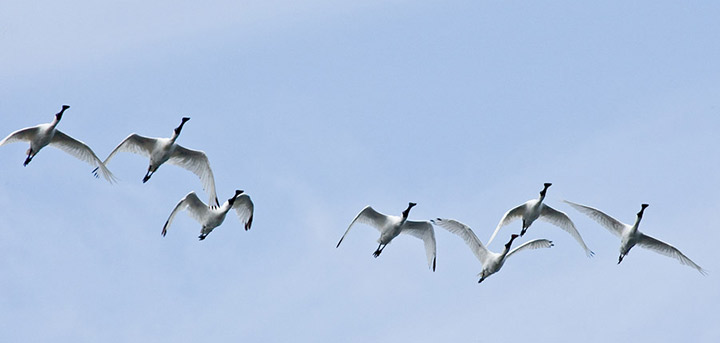
As a South Korean organisation with both domestic and overseas membership, Birds Korea has a clearly-defined mission. We work for the conservation of birds and their habitats in the ROK and the Yellow Sea Eco-region as part of genuinely sustainable development. Our work is based on research (bird counts and analysis; literature review; analysis of habitat change); planning and design (including organising information, providing advice, and where possible supporting existing conservation structures and activities); and awareness-raising and education.
To use existing resources efficiently, we always aim to find the best ways to gather, organise, analyse and share the information that we have. To this end, we have already conducted thousands of days of bird counts, collected hundreds of site coordinates, and produced and arranged thousands of images of birds and their habitats. As much as our capacity allows, we have also analysed much of our own data in addition to that found in published sources and we have always shared this information freely and openly. At all times, we cite sources clearly, and we produce our work in both Korean and in English, published in reports and on our websites. As we intend, the results of our work are therefore open to all – within the ROK, throughout the Yellow Sea Eco-region and globally.
We also actively provide data, insights, and our support to numerous existing conservation bodies and organisations. We do much to promote conservation at both the local level (as at the Geum Estuary and in Mokpo) and through larger-scale initiatives, including e.g. the UNDP-GEF Yellow Sea Project, the East Asian-Australasian Flyway Partnership, the Ramsar Convention and the International Year on Biodiversity. All that we do depends on the generosity and support of our members, of donors and of other organisations. We believe that our work has helped strengthen the work of others, and that their work has greatly strengthened our own.
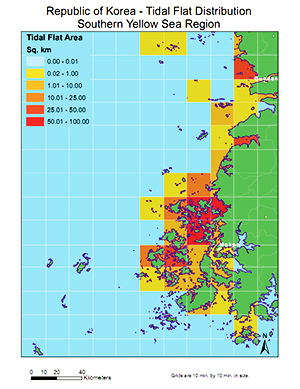
At the same time, since the founding of Birds Korea in 2004, the actual conservation status of many of the sites and species we and others are working to conserve has worsened. Although major information gaps remain (on e.g. the extent of habitat loss and degradation and on the suspected rates of decline in some species), rivers are being dredged and dammed as part of the Four Rivers construction project; estuaries are still barraged and increasingly developed; and the sea-walls at both Namyang Bay and Saemangeum have been completed. Reclamation still continues at Song Do, despite the national commitment to permit no more large-scale reclamation, and proposed tidal power plants threaten other internationally important wetlands.
With so many issues and so many information-gaps, what is the most efficient way for Birds Korea to work - now and in the months and years ahead? How can we help to express our concerns, and help to express the concerns of others?
One important way is to rationalise our work even further. We are doing this through creating clearer “structures” (recent examples include the online Birds Korea Checklist and the Birds Korea Gallery). This includes reorganising much of the growing body of information on key species and habitats in the South Korean part of the Yellow Sea into a “conservation blueprint”.
Blueprints are created by architects and planners to describe the internal structure of a building. Builders then create the actual building, based on this blueprint. Other teams of people (e.g. plumbers, electricians and painters) then make the building habitable, covering up the skeleton of the building as they do so, while people who live in the building then make it into a home.
We believe that this is a good analogy for the work we are now undertaking.
The Birds Korea blueprint is a blueprint for the conservation of birds and their habitats within a specific part of the Yellow Sea. It is a structure for organising and presenting key information that can then be used to improve or develop conservation strategies at a range of scales. The Blueprint aims to support conservation at single sites within the ROK and the Yellow Sea Eco-region, and at the level of species’ flyways that stretch north to Alaska, southwest to the Bay of Bengal, and south to Australia and New Zealand.
So what is The Blueprint, and how will it work?
1) Contents: General
The Blueprint is not a national overview nor is it a scientific report written to prove a certain hypothesis. It does not aim to list every organisation that does good work or to describe every site that is threatened.
Instead, The Blueprint is a scientifically-rigorous yet easily accessible report in progress. It organises data and insights gathered through years of work, selecting information on key habitats and key species arranged in a way that can be more easily used to support the development of conservation strategies. It contains data, images and references, examples and contact details in both Korean and English.
It is therefore a useful resource as well as a platform for organisations to communicate about their conservation work to a new audience.
2) Timing and Process: General
The Blueprint is both an online resource and a document that can be updated and presented at major meetings. The 2010 edition is being prepared in time for the Tenth Conference of the Parties to the Convention on Biological Diversity (CBD COP 10) which is being held in Nagoya, Japan (October 2010). Sharing of the first version of The Blueprint at the CBD COP 10 should help to raise international awareness of the importance of the South Korean part of the Yellow Sea, and also help to identify information that needs to be included in future editions.
3) Geographical Scope of the “Yellow Sea Blueprint Region” (YSBR)
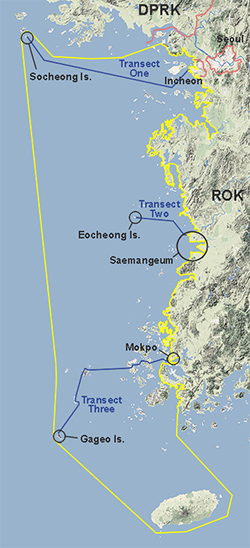
The Blueprint is focused on bird species found within easily-accessible areas of the South Korean part of the Yellow Sea, an area Birds Korea calls the “Yellow Sea Blueprint Region” or YSBR.
The YSBR is contained within an irregular rectangle between 37°50’N and 33°20’N, and from 124°30’E and 126°55’E. The northern edge of the YSBR lies approximately 40km south of the Hwanghaenam Province coast (DPRK), and the southern edge lies within 10km of the coastline of Jeju Island. While the western edge is open sea, the eastern edge follows the deeply indented western coast of the ROK, including all islands and areas of inter-tidal wetland found within 2 km of the sea.
The YSBR supports a huge range of migratory bird species, many in internationally important concentrations.
The YSBR is but one important part of the wider Yellow Sea, a shallow sea shared by the ROK, China and the DPRK. Lessons learned in the YSBR should be of value to conservation work in other parts of the Yellow Sea.
In addition, almost all issues affecting species within the YSBR are also found elsewhere within the Republic of Korea. This means that The Blueprint has value for understanding threats to species and sites along the Korean south and east coasts, and e.g. along some of its rivers. The Blueprint can therefore be used to complement the work being done by other domestic organisations, outside of the YSBR, saving time and other resources
4) The Import and Export of Best Information
Conservation of avian biodiversity in the Yellow Sea Eco-region is especially challenging, and cannot be achieved by the effort of one nation alone. There needs to be support, collaboration, and sharing of best information at local, national and international levels.
Despite the great efforts of some organisations, conservation initiatives in the Yellow Sea still remain rather poorly-known within the ROK and outside of the region. Reports produced by these initiatives contain little or no information on e.g. seabirds-at-sea or on specialist island-breeders like the globally Vulnerable Styan’s Grasshopper Warbler Locustella pleskei.
This is why much of Birds Korea’s research effort is focused on the YSBR, and why The Blueprint is being created in this way.
The Blueprint aims to fill some of these extremely important information gaps on species and their habitats, and on the threats to them, making it easier for other organisations to develop their own conservation initiatives for key species found within the YSBR and the Yellow Sea Eco-region.
At the same time, The Blueprint aims to gather the best information on the same key species, and on research and successful conservation strategies from outside of the YSBR.
Bringing this information together into one place – The Blueprint - is essential if resources, time and species are to be saved.
5) Three Main Habitats and Key Sites
Because most sites contain more than one habitat type, and most habitats in the YSBR overlap in some way, habitats within The Blueprint are organised into three main types: (i) inter-tidal areas, (ii) open sea areas and (iii) islands.
- For inter-tidal areas, The Blueprint contains data and maps showing national loss of habitat, while focusing on Song Do, Saemangeum / the Geum Estuary, and on Mokpo Namhang Urban Wetland.
- For open sea areas, The Blueprint provides some background information on existing seabird initiatives and focuses on seabirds-at-sea along three survey-transects (between Incheon and Socheong Islands; between Yeon Do and Eocheong Islands; and between Bigeum and Gageo Islands).
- For islands, The Blueprint identifies some of the main bird communities north-south on eight islands in the West Sea and focuses on Socheong, Eocheong and Gageo Islands.

6) Key Species
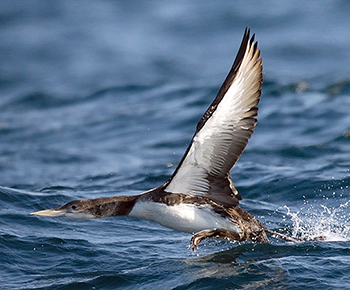
Because approximately 500 species of bird have been recorded in the YSBR, The Blueprint focuses on representative species of each of the three main habitats. These are most especially species of global conservation concern and those species that are already the focus of ongoing conservation work.
Selected representative species of inter-tidal wetlands include e.g. Black-faced Spoonbill Platalea minor, Spoon-billed Sandpiper Eurynorhynchus pygmeus, and Great Knot Calidris tenuirostris.
Selected representative species of open sea areas include Streaked Shearwater Calonectris leucomelas, Swinhoe’s Storm Petrel Oceanodroma monorhis and loons (most especially Yellow-billed Gavia adamsii and Red-throated Loons Gavia stellata).
Selected representative species of islands include Styan’s Grasshopper Warbler and Black Woodpigeon Columba janthina, in addition to migrants and nesting seabirds.
7) Threats to Sites, Habitats and Species
The Blueprint relates the threats to sites and habitats to threats to key species (e.g. the impacts of reclamation on Spoon-billed Sandpiper and Great Knot within the YSBR and along the Flyway; the impacts of oil on loons; and the impacts of habitat degradation on islands on Styan’s Grasshopper Warbler).
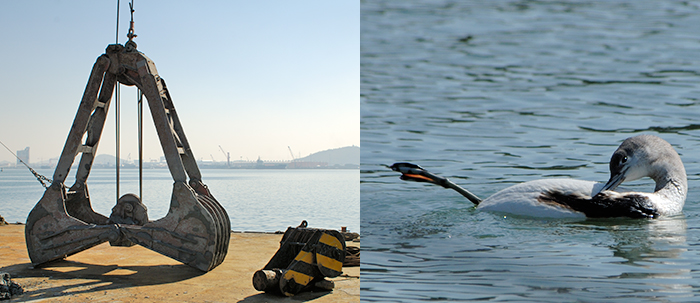
8) Conservation Responses
An important part of The Blueprint is the inclusion of conservation initiatives and examples of conservation practice from within and outside of the YSBR.
The UNDP-GEF Yellow Sea Project has done much already, for example, to support and promote site-based conservation projects within the Yellow Sea. Other organisations like BirdLife International have done much for the conservation of key species like the Spoon-billed Sandpiper and the Black-faced Spoonbill throughout their ranges through developing species-based Action Plans.
The Blueprint aims to identify and bring together examples of such work, in order to learn from them, to promote them, and to use them to motivate, inform and support conservation work in this region.
9) Blueprint Versions One and Two
The Birds Korea Blueprint 2010 will be published and posted online in mid-October 2010. It will be added to and improved, with the second published version to be produced in time for the IUCN World Congress to be held on Jeju in 2012.
10) The Birds Korea Blueprint 2010: Contents
The Birds Korea Blueprint 2010 will contain between 60 and 150 pages (dependent on contributions and time available). The proposed Contents will be refined throughout August and September and finalised by October 1st.
The proposed outline (July 2010) is as follows:
| Page # | Chapter / Section | Contents | Notes |
| COVER | |||
| INSIDE COVER | Images Birds Korea mission statement Blueprint Citation: Funded by: | ||
| P. 1 | “Introductory” Section | Contents Table | |
| 2-3 | Executive Summary | ||
| 4-5 | INTRODUCTION (1) (Process and Context) | The YSBR | Why / How YSBR selected and defined |
| 6-9 | The YSBR, the Yellow Sea and the East Asian-Australasian Flyway | ||
| 10-13 | Review of Main Literature and identification of main Information Gaps | ||
| 14-17 | Main conservation structures: National Monuments, Protected Areas, Ramsar sites, Wetland Conservation Areas, Ramsar, CBD, ROKAMBA New Act on Preservation and Green Growth | ||
| 18-21 | INTRODUCTION (2) (Physical and Biological) | Climate and Sea currents of the YSBR | |
| 22-25 | Main Vegetation Types 1) Inter-tidal and Sub-tidal 2) Islands and coastal | ||
| 26-29 | The Three Main Habitat Types | ||
| 30-33 | INTRODUCTION (3) Avian Biodiversity | Key Species | |
| 34-37 | INTER-TIDAL WETLANDS: YSBR | Changing Landscape of Coastline: Reclamation | |
| 38-41 | Birds Korea National Shorebird Surveys (and estuaries of Four Rivers) | ||
| 42-47 | Saemangeum Shorebird Monitoring Program | ||
| 48-53 | Mokpo Namhang Urban Wetland | ||
| 54-55 | Summary of Status and Threats | ||
| 56-57 | Species Case Studies | Great Knot | |
| 58-59 | Spoon-billed Sandpiper | ||
| 60-61 | Black-faced Spoonbill | ||
| 62-63 | Chinese Egret | ||
| 64-65 | Saunders’s Gull | ||
| 66-69 | ISLANDS | Typical Bird Communities of Islands | |
| 70-73 | Socheong Island | ||
| 74-77 | Eocheong Island | ||
| 78-81 | Gageo Island | ||
| 76-81 | Key Species | Species of Special Conservation Concern on islands | |
| 82-83 | Styan’s Grasshopper Warbler | ||
| 84-85 | Black Woodpigeon | ||
| 86-87 | Swinhoe’s Storm Petrel | ||
| 88-89 | MARINE AREAS | Seabirds of the YSBR | |
| 90-93 | Birds Korea Seabird Transect Results | ||
| 94-95 | Black-tailed Gull | ||
| 96-97 | Streaked Shearwater | ||
| 98-99 | Swinhoe’s Storm Petrel | ||
| 100-103 | Summary of Potential Threats to Seabirds within the YSBR | ||
| 104-107 | CONSERVAYION OF AVIAN BIODIVERSITY OF THE WIDER YELLOW SEA ECO-REGION | China? | East Coast? |
| 108-109 | Bay of Bohai | ||
| 110-111 | DPRK | ||
| 112-113 | RESEARCH AND CONSERVATION OF THE YSBR’S AVIAN BIODIVERSITY | Site-level | Muan? |
| 114-117 | Mokpo Namhang Urban Wetland | ||
| 118-119 | Important Bird Areas? | ||
| 120-121 | Species-Based | Yellow-billed Loon | |
| 122-127 | Black-faced Spoonbill 1. ROK (confirmed) 2. Hakata Bay (confirmed) 3. Taiwan | ||
| 128-131 | Monitoring Yellow Sea Migrants in Australia Program (confirmed) | ||
| 132-133? | Bar-tailed Godwit? | ||
| 134-137 | ACTIONS NEEDED | ||
| 138-139 | CLOSING SECTION | References and Acknowledgements | |
| INSIDE BACK COVER | Acknowledgements | ||
| BACK COVER | Endorsements | To date funded by: RUFFORDS SMALL GRANT UNIVERSITY OF NEWCASTLE QWSG Additional donors and Endorsements? |
11) Contributions and Contributors
We welcome contributions to The Blueprint at all times.
Contributing authors are asked for articles on key species or conservation initiatives written in Korean or English (or ideally in both languages), approximately 600 words in length, supported by three or more images of the site or species. The writing style can be scientific or popular. The article needs to be factual, informative, well-referenced, and focus on key species, key habitats or important conservation activities.
Offers to contribute articles to The Birds Korea Blueprint 2010 should please be confirmed by August 25th; and contributions provided by September 1st in one language, or by September 10th if in both languages.
Articles when received will be posted online and, following further editing as appropriate, included in The Birds Korea Blueprint 2010 (and as appropriate in subsequent editions with the author’s permission).
All authors will retain copyright over their images and articles at all times, and should provide contact details if they want to have these made public.
Editing of the 2010 Blueprint will continue through September. We welcome support with editing, translation and layout.
No further submissions or major revisions to the 2010 edition will be possible after October 5th.
Final proof-reading will be conducted between October 5th and October 10th.
Printing will take place between October 11th and 13th.
The Birds Korea Blueprint 2010 will be released in mid-October. It will be posted online and hard copies will be transported by Birds Korea to CBD COP10. It will then be available for posting and use by other organisations, provided that appropriate citation is provided.
Birds Korea, August 8, 2010
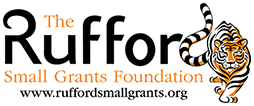
Development of The Blueprint 2010 is supported by an essential
Rufford Small Grant for Nature Conservation.



